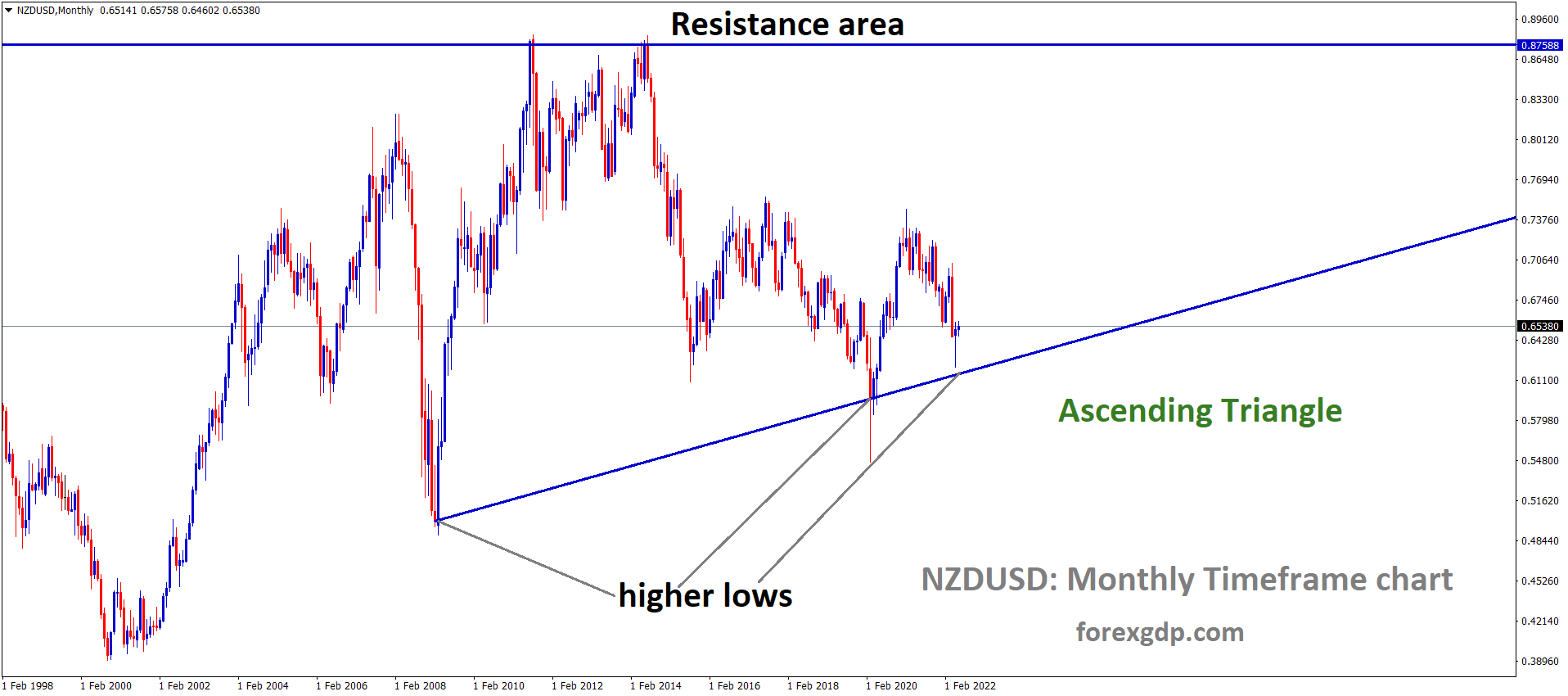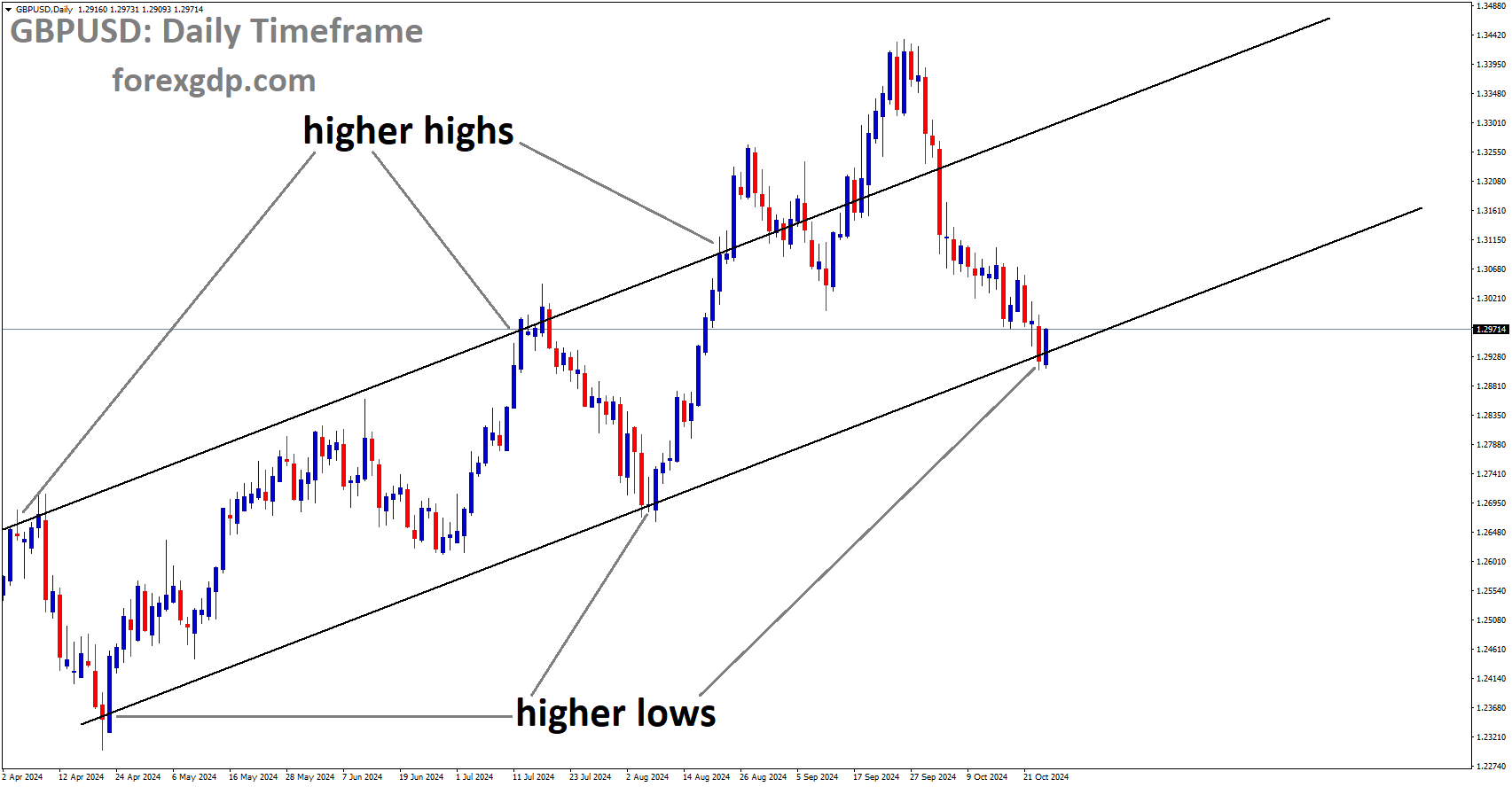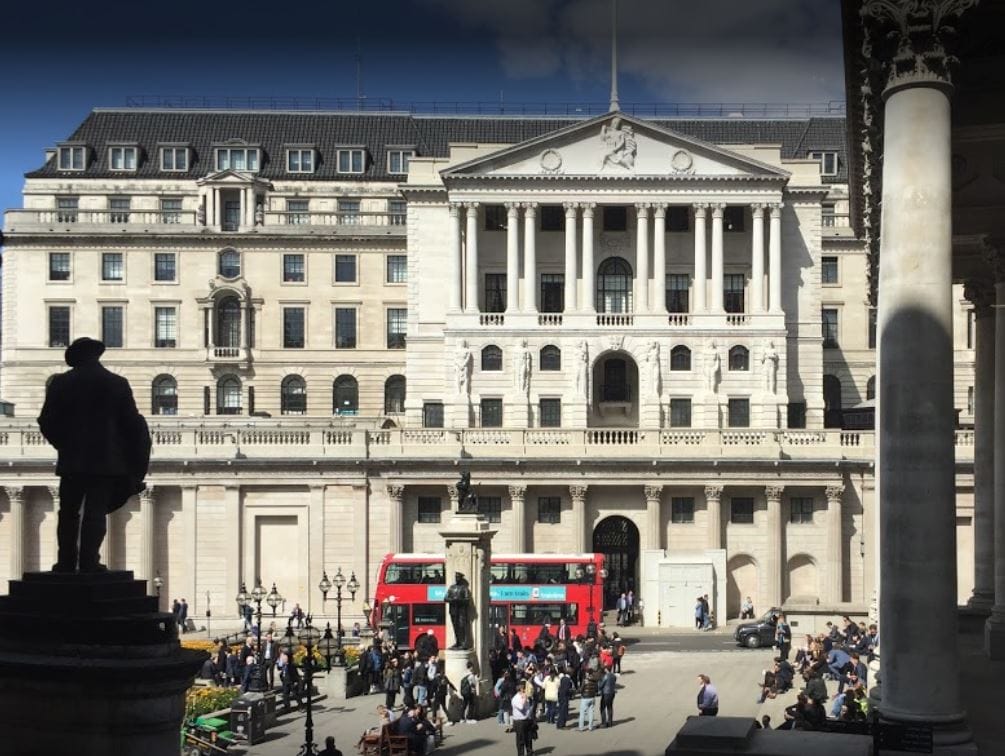Weekly Forecast Video on Forex, BTCUSD, XAUUSD
Stay ahead in the markets with our detailed analysis of gold and forex trade setups for this upcoming week, Oct 21 to Oct 25.
XAUUSD – Historic Gold Surge Driven by Middle East Conflict and US Political Anxiety
Gold Prices Surge Amid Geopolitical Tensions and Economic Concerns: What You Need to Know
Gold has been a topic of interest for centuries, valued not only as a precious metal but also as a safe-haven investment in times of uncertainty. Recently, the price of gold has experienced a significant increase, driven by various global factors such as geopolitical tensions, a weakening U.S. dollar, and concerns over the upcoming U.S. elections. Let’s dive into why gold prices are soaring, and what this could mean for you as an investor or someone curious about the markets.
Gold’s Appeal as a Safe Haven
Gold has long been considered a “safe haven” during times of crisis. When there’s uncertainty, especially on a global scale, investors often flock to assets like gold that tend to hold or increase in value during turbulent times. Currently, the combination of geopolitical instability and looming economic changes has driven more people toward this precious metal.

XAUUSD has broken the Ascending channel in the upside
Why Gold is Seen as a Safe Investment
In times of economic or political turmoil, the value of traditional investments like stocks or bonds can fluctuate wildly. Gold, on the other hand, tends to retain its value or even appreciate, offering a protective hedge against market volatility. This is why we see gold prices rise during periods of global unrest, such as the current geopolitical tensions in the Middle East.
Moreover, gold doesn’t rely on any particular economy or government to sustain its value. It’s been historically recognized across the world as a store of value, making it an appealing option when traditional currencies, like the U.S. dollar, face pressures.

The Influence of Geopolitical Tensions
One of the primary reasons for the recent surge in gold prices is the increasing geopolitical tensions around the globe. In particular, the ongoing conflict in the Middle East has sparked concern, leading to a rise in demand for gold.
How Geopolitical Uncertainty Affects Gold Prices
When geopolitical conflicts arise, markets can become highly volatile. Investors may pull money out of riskier assets, such as stocks, and look for safer alternatives, like gold. The recent escalation of tensions between Israel and its neighbors, for instance, has contributed to the rise in gold prices.
Beyond the Middle East, political instability in other regions, such as upcoming U.S. elections, also adds uncertainty. Investors are wary about the potential impact of political changes on the economy and global markets, and gold becomes a hedge against these risks.
Economic Factors Driving Gold Higher
Beyond geopolitical unrest, there are several economic factors that have played a role in pushing gold prices higher. Key among these are declining U.S. Treasury yields and a weakening U.S. dollar.
The Relationship Between Treasury Yields, the Dollar, and Gold
The U.S. Treasury yields have been falling, which generally makes non-yielding assets like gold more attractive. When Treasury yields drop, the opportunity cost of holding gold decreases, encouraging investors to shift into the precious metal. Additionally, the U.S. dollar has weakened, further boosting gold prices. Gold is often priced in dollars, so when the value of the dollar declines, it takes more dollars to purchase the same amount of gold.
Expectations Around Central Banks’ Policies
In addition, the stance of major central banks on monetary policies can influence gold prices. The possibility of looser monetary policies, such as lowering interest rates or implementing more stimulus measures, tends to weaken the dollar and drive investors toward gold.
There has been speculation that central banks may begin to ease their policies soon due to inflation levels in countries like the U.K. and concerns about economic growth in the U.S. A cut in interest rates makes gold, which doesn’t yield interest, more appealing in comparison to other assets.
How Much Higher Could Gold Go?
With all these factors in play, analysts are predicting that gold prices could continue to climb in the near future. Some estimates suggest that gold could reach new all-time highs, possibly surpassing $3,000 an ounce within the next 6-12 months. These predictions are based on the assumption that geopolitical tensions will remain elevated, and economic uncertainties will persist.
What Experts Are Saying
Many market experts believe that the demand for gold will remain strong as long as global tensions and uncertainties continue. Some even see gold as a long-term hedge against not only political risks but also inflation. Historically, gold has performed well during periods of high inflation, offering a way to preserve purchasing power.
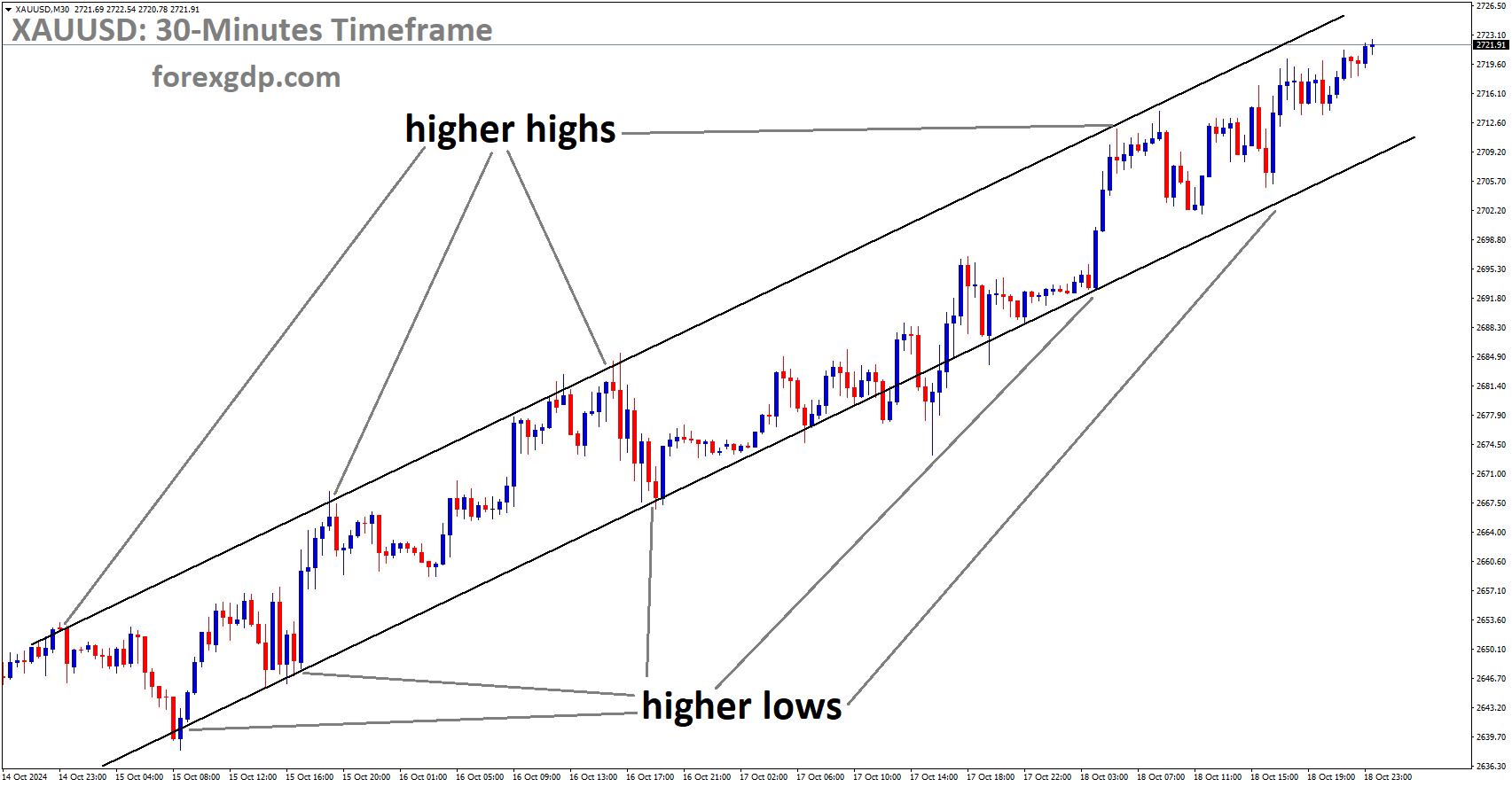
XAUUSD is moving in an uptrend channel, and the market has rebounded from the higher low area of the channel
What Does This Mean for Investors?
So, what does this rise in gold prices mean for you? If you’re already invested in gold, this surge could represent significant gains in your portfolio. On the other hand, if you’re considering buying gold, now might be a good time to explore your options, especially if you believe that global instability and economic concerns will persist.
Should You Invest in Gold?
Gold can be a valuable addition to a diversified portfolio, particularly for those looking for stability during uncertain times. It’s important to remember, however, that gold doesn’t generate income like stocks or bonds. Its value comes primarily from capital appreciation, which means that investors looking for growth should weigh the pros and cons carefully before diving in.
If you’re new to investing in gold, consider different forms of gold investment—whether it’s purchasing physical gold (such as coins or bars), investing in gold-related ETFs, or buying shares in mining companies.
How to Approach the Market Moving Forward
While gold has been on the rise, it’s crucial to keep an eye on broader market trends. Geopolitical events can evolve quickly, and economic conditions can shift, potentially affecting gold prices. For investors, staying informed and understanding the factors that influence gold can help make better investment decisions.

The Importance of Patience and Timing
Investing in gold or any commodity requires patience. Markets can fluctuate in the short term, and jumping in or out of an investment based on daily news can lead to poor decision-making. If you believe in the long-term potential of gold, it’s important to stay committed to your strategy and avoid making knee-jerk reactions to market volatility.
Final Summary
Gold has surged in recent months, driven by a mix of geopolitical tensions, economic concerns, and a weakening U.S. dollar. The metal’s role as a safe-haven asset makes it particularly attractive during uncertain times, and analysts predict that its price could continue to rise in the near future.
For those considering investing in gold, it’s crucial to weigh the potential benefits against the risks, especially given its lack of income generation. As with any investment, understanding the factors that influence gold prices can help you make more informed decisions. Keep an eye on the news, stay patient, and consider how gold fits into your overall investment strategy.
EURUSD – Euro Bounces Back Against the Dollar, But Future Path Looks Hazy
EUR/USD Recovery and Uncertain Outlook Amidst ECB Policy Moves
The EUR/USD currency pair has seen some recovery in recent times, but its future remains clouded by uncertainty, particularly with the European Central Bank (ECB) expected to continue easing its monetary policy. Global events, such as the upcoming U.S. presidential elections, could also have a significant impact on the Eurozone’s economy. In this article, we’ll dive into the factors influencing the EUR/USD pair, what traders can expect in the near term, and how the larger economic environment plays a role in these fluctuations.
The ECB’s Monetary Policy: What’s Happening Now?
The European Central Bank has been in the spotlight lately, as it continues its policy of cutting interest rates to support the Eurozone economy. On Thursday, the ECB lowered its rate on the deposit facility by 25 basis points (bps) to 3.25%, marking the third rate cut this year. These actions are part of a broader effort by the ECB to stimulate economic growth in the region.
Why the ECB is Cutting Rates
The ECB’s focus on reducing interest rates comes from concerns about slowing growth in the Eurozone. With inflation showing signs of being under control, ECB officials have been confident that these rate cuts are necessary to revitalize the economy. Even though inflation management remains a key goal, it seems that the immediate priority is ensuring growth stays on track.
At a press conference following the rate cut announcement, ECB President Christine Lagarde hinted at the challenges facing the Eurozone. Although she didn’t provide specific clues on future rate decisions, traders are already betting that another 25-bps cut could be on the cards before the year ends. The expectation is that the ECB will continue to reduce rates in an effort to support the Eurozone economy amid global uncertainties.
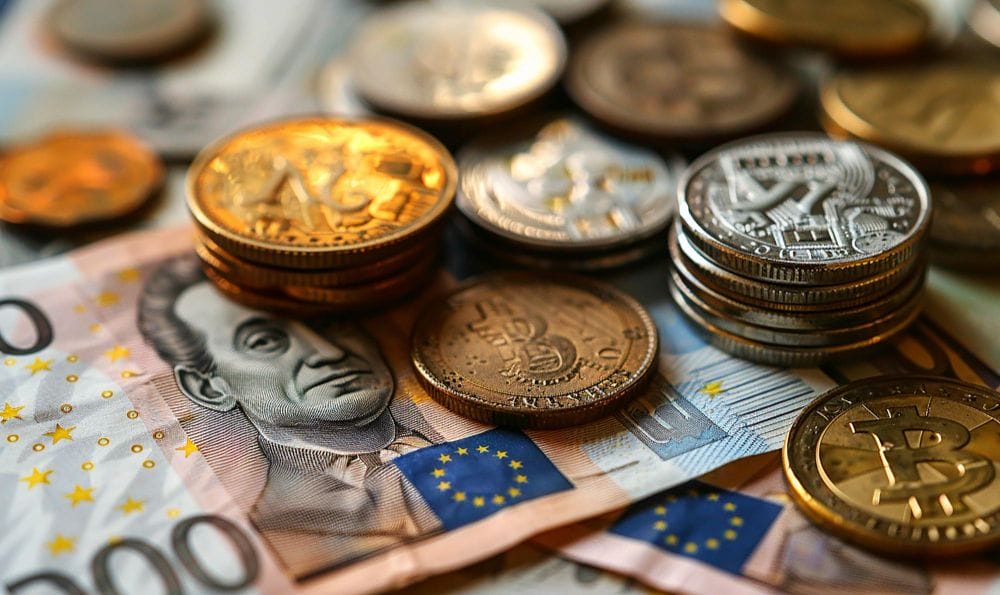
Potential U.S. Election Impact on the Eurozone
Global events, especially in the U.S., play a significant role in influencing the EUR/USD currency pair. With the upcoming U.S. presidential elections, there is growing speculation about how the outcome could impact the Eurozone economy.
If former U.S. President Donald Trump wins the election, there could be new challenges for the European economy. Trump’s approach to trade policies has historically included imposing tariffs and restrictions, which could potentially hurt the Eurozone, given its reliance on international trade. As ECB President Lagarde mentioned, any barriers to trade would be detrimental to an economy as open and trade-dependent as Europe’s.
The potential for disruptions to oil prices, particularly due to geopolitical tensions in the Middle East, could also influence the Eurozone. While the ECB is closely monitoring these risks, it remains focused on supporting the region’s economic growth with continued policy adjustments.
Market Movers: What’s Affecting EUR/USD Right Now?
Despite the ECB’s rate cuts, the EUR/USD has managed to recover slightly after a period of decline. On Friday, the currency pair rebounded after hitting a low of 1.0800 on Thursday, signaling that there might still be some room for optimism. However, the outlook for EUR/USD remains uncertain.
U.S. Dollar’s Pause Provides EUR/USD Some Relief
The U.S. Dollar, which has been on a strong upward trend recently, took a pause on Friday, giving the Euro a chance to regain some ground. The U.S. Dollar Index (DXY), which tracks the value of the dollar against other major currencies, has struggled to push higher, which is contributing to the temporary relief seen in the EUR/USD pair.
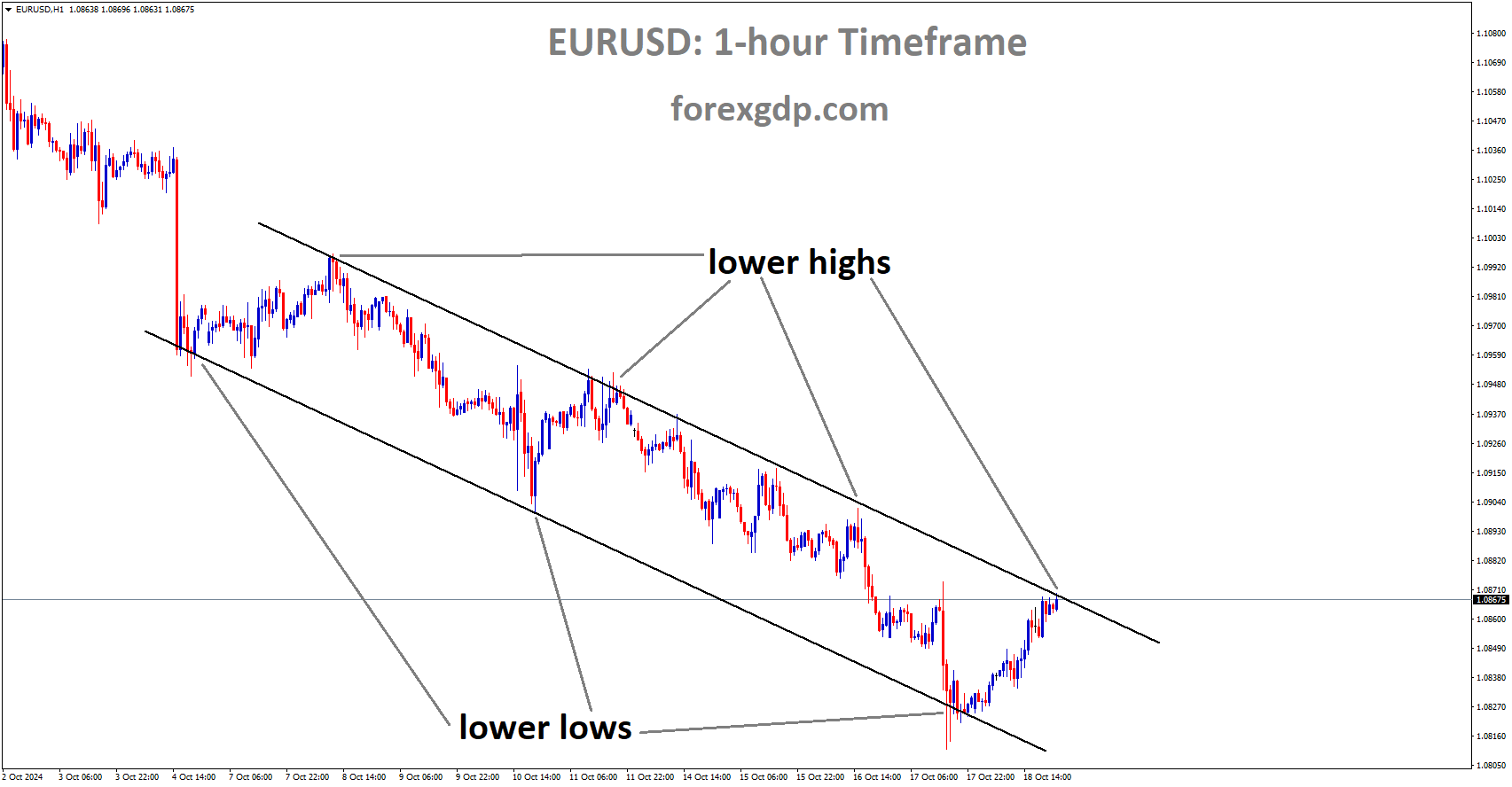
EURUSD is moving in a descending channel, and the market has reached the lower high area of the channel
This slight pause in the dollar’s rally is largely due to stronger-than-expected U.S. economic data, particularly in consumer spending and jobless claims. However, the overall strength of the U.S. economy continues to support the U.S. dollar, which could limit the upside potential for the Euro.
Looking Ahead: What Can We Expect?
As we move closer to the end of the year, traders will be paying close attention to several key factors that could influence the direction of EUR/USD.
Fed’s Rate-Cut Path
One of the most significant factors is the Federal Reserve’s (Fed) approach to interest rate cuts. Recently, traders have been speculating that the Fed may opt for gradual rate cuts, instead of large cuts. The September data out of the U.S. has been relatively strong, reducing fears of an economic slowdown. This suggests that the Fed is likely to proceed with smaller rate cuts in November and December, which could keep the U.S. dollar strong.
U.S. Presidential Elections
Another major event to watch is the upcoming U.S. presidential elections. Polls indicate a tight race between Donald Trump and Kamala Harris. Many investors believe that a Trump victory could lead to economic uncertainty in the Eurozone due to his unpredictable trade policies. As the election approaches, market participants are likely to react to any shifts in polling data, which could create more volatility in the EUR/USD pair.
What Does This Mean for Traders?
For traders, the current environment around EUR/USD presents both challenges and opportunities. On one hand, the Euro is facing pressure from ongoing ECB rate cuts, while on the other hand, the U.S. dollar’s rally may take a breather if economic data softens or if the election creates uncertainty.
Keep an Eye on Economic Data
It’s important for traders to stay focused on key economic indicators from both the Eurozone and the U.S. For the Euro, economic growth data and any further announcements from the ECB will be critical. In the U.S., continued strong economic data could keep the dollar strong, but any signs of weakness may give the Euro a chance to recover.

Volatility Expected During U.S. Elections
As the U.S. presidential election draws nearer, expect volatility in the EUR/USD pair. Traders should be prepared for sudden movements in the market, especially as polling data shifts or new developments arise in the race. Keeping a close watch on election-related news could provide insights into potential short-term trading opportunities.
Final Thoughts
The EUR/USD pair continues to be influenced by a complex set of factors, from the ECB’s ongoing rate cuts to the potential impacts of the U.S. presidential elections. While the Euro has shown some signs of recovery, the overall outlook remains uncertain. For traders, staying informed and adapting to changing market conditions will be crucial in navigating the upcoming months.
As always, whether you’re an experienced trader or just getting started, it’s important to remain patient and strategic in your approach. The markets can change rapidly, especially in times of political and economic uncertainty. Keep an eye on key economic data, be prepared for potential volatility around the U.S. elections, and adjust your trading strategies as needed.
USDJPY – USD/JPY Struggles to Break 150 as Dollar’s Momentum Stalls
Why USD/JPY Is Facing Challenges Near 150: What Traders Should Know
When you look at the current situation surrounding the USD/JPY pair, one thing is clear: it’s a rollercoaster for traders. The currency pair is having a tough time breaking above the 150 mark, a psychological level that has caught everyone’s attention. Why is this happening, and what should traders keep in mind as they navigate the ups and downs? Let’s dive into the factors playing into the dynamics of this exchange rate and explore how global events are shaping it.
The US Dollar Struggles to Maintain Its Upward Momentum
For the past few weeks, the US Dollar (USD) has been on a bit of a winning streak, gaining strength against several major currencies. However, recently, this upward momentum seems to be slowing down, especially against the Japanese Yen (JPY). Many traders were optimistic that the USD could continue to push higher, but as it approaches the 150 level, the pace has decelerated.
So, what’s causing this pullback? One of the main reasons is the market’s recalibration of expectations around the Federal Reserve’s (Fed) interest rate policy. Earlier, traders were expecting a more aggressive move from the Fed, including the possibility of a larger-than-normal interest rate cut in November. However, as we’ve moved closer to the decision date, those expectations have tempered, leading to a pause in the US Dollar’s strength.

How Market Sentiment Affects USD/JPY Movements
Global market sentiment plays a significant role in the USD/JPY exchange rate. Over the past few months, we’ve seen shifts in this sentiment due to political, economic, and financial factors. At the moment, the overall mood of the market is relatively positive, and this can be attributed to a variety of factors, including political developments in the United States.
Kamala Harris, the Democratic candidate for the presidency, has gained some traction in national polls, leading to a sense of stability and optimism in the markets. While this might seem unrelated to currency pairs, political stability in a major economy like the US can boost investor confidence, leading to an increase in demand for assets like the US Dollar. However, even with this positive sentiment, the USD/JPY pair faces resistance near the 150 level, and the currency’s rally seems to have stalled.
On the other hand, Japanese investors have also been active, and shifts in Japan’s economic data are adding to the complex picture of the USD/JPY movements. One key factor is inflation in Japan, which has picked up pace recently.
Japan’s Inflation: A Key Factor for the Yen
Inflation in Japan has been an ongoing issue, and recent data shows that it’s not going away anytime soon. In September, Japan’s National Core Consumer Price Index (CPI) — a measure that excludes volatile food and energy prices — rose by 2.1%. This marks an acceleration from the previous month and signals that inflationary pressures in Japan are growing.
This increase in inflation is important for the USD/JPY pair because it puts pressure on the Bank of Japan (BoJ) to act. The BoJ has been notoriously dovish over the past few years, keeping interest rates low to stimulate the economy. However, with inflation rising, there’s growing speculation that the BoJ might have to shift gears and consider raising interest rates to combat these inflationary pressures.
If the BoJ decides to hike rates, it could lend strength to the Japanese Yen, making it harder for the US Dollar to push past the 150 mark. Traders are closely watching the BoJ’s next moves, as any shift in policy could lead to significant changes in the USD/JPY exchange rate.
The Federal Reserve’s Interest Rate Path: What’s Next?
While inflation in Japan is one piece of the puzzle, the Federal Reserve’s interest rate policy is another key factor to consider when looking at the USD/JPY pair. Over the past year, the Fed has been hiking interest rates in an effort to control inflation in the US. This tightening cycle has supported the US Dollar, as higher interest rates tend to attract more foreign investment, increasing demand for the currency.
However, the outlook for future rate hikes is becoming less certain. According to recent market data, traders are no longer expecting a large, aggressive rate cut from the Fed in November. Instead, the consensus is that the Fed might opt for smaller, more gradual rate cuts. This shift in expectations is causing some hesitation among USD/JPY traders, as the initial optimism for a continued Dollar rally fades.

USDJPY is moving in an Ascending channel, and the market has reached the higher low area of the channel
Investors are now anticipating a 25 basis point cut in November and December, rather than the previously speculated 50 basis point cut. This change in market sentiment has made it harder for the USD to maintain its upward momentum, especially as it approaches the key psychological level of 150 against the Yen.
What Should Traders Watch for Next?
For traders looking at the USD/JPY pair, there are several important factors to keep an eye on over the coming weeks. First and foremost, the Federal Reserve’s next moves will be crucial. Any signs that the Fed is leaning toward a more aggressive or more dovish stance could have a significant impact on the exchange rate.
In addition, keep an eye on the Bank of Japan’s actions. Rising inflation in Japan could force the BoJ to reconsider its current policy, and any hints of a rate hike would likely lead to Yen strength, putting further pressure on the USD/JPY pair.
Lastly, broader market sentiment, particularly around the US political landscape, will also play a role. While politics might not always have a direct impact on currency markets, any signs of increased stability or instability in the US could influence demand for the US Dollar, and by extension, the USD/JPY exchange rate.
The Road Ahead for USD/JPY: A Balancing Act Between Two Economies
As we look ahead, it’s clear that the USD/JPY pair is in a tricky spot. The US Dollar has had a strong run, but its rally is starting to show signs of fatigue. Meanwhile, rising inflation in Japan is creating uncertainty around the Bank of Japan’s next moves, which could add strength to the Yen and make it harder for the USD to break through the 150 level.

For traders, the next few weeks will be all about watching these key economic indicators and staying on top of market sentiment. While the outlook for the USD/JPY pair remains positive in the long term, the short-term picture is more uncertain, and traders will need to be flexible in their strategies as new data emerges.
Summary
In a world where both the Federal Reserve and the Bank of Japan are facing tough decisions about interest rates, the USD/JPY pair is stuck in the middle. On one side, the US Dollar has been strong, but traders are beginning to pull back their expectations for aggressive rate cuts from the Fed. On the other side, Japan’s rising inflation is putting pressure on the Bank of Japan to shift its stance, which could lead to a stronger Yen.
For now, the USD/JPY pair is facing resistance at the 150 mark, and traders will need to keep a close eye on both US and Japanese economic data to get a clearer sense of where the currency pair is headed next. As always, staying informed and adaptable will be key to navigating the ups and downs of this dynamic currency pair.
GBPUSD – UK Retail Sales Upswing Fuels Pound Sterling Rebound
Pound Sterling Gains Momentum: What’s Driving the Recent Rebound?
The Pound Sterling (GBP) recently made a notable recovery, pushing back against the US Dollar (USD) as a result of some unexpected developments in the UK economy. One of the most significant drivers of this bounce was the UK’s Retail Sales for September, which surprised analysts with an increase rather than the anticipated decline. This unexpected growth in consumer spending has raised questions about the broader economic outlook, particularly regarding interest rates and the strength of the UK economy.
In this article, we’ll dive into what’s fueling the Pound’s rebound, why UK Retail Sales have such a profound impact on the currency, and how this affects both domestic and global markets. Whether you’re curious about the state of the UK economy, or you simply want to understand how retail data impacts currency movements, let’s break it all down.
UK Retail Sales: A Pleasant Surprise
Retail Sales data is a key indicator of consumer spending, and in September, the UK saw better-than-expected numbers. Sales rose by 0.3% month-on-month, whereas economists had expected a drop of the same percentage. Annually, Retail Sales showed an impressive 3.9% increase, outpacing both the 3.2% forecast and the previous month’s revised growth of 2.3%. This positive performance was largely driven by strong sales in non-food items, including department stores.
So, why is this Retail Sales data so crucial? For one, consumer spending is often considered the backbone of economic growth. When people are buying more, it typically indicates confidence in the economy. More spending means businesses thrive, jobs are created, and the economy, in general, looks healthier. This creates a ripple effect that can even influence interest rate decisions.

How Retail Sales Data Impacts the Pound Sterling
The recent uptick in Retail Sales has provided a much-needed boost to the Pound Sterling. It paints a more optimistic picture of the UK’s economic health, reducing the likelihood of immediate interest rate cuts by the Bank of England (BoE). Following disappointing inflation data earlier in the week, some market participants had begun speculating that the BoE would need to cut rates to stimulate the economy. However, this Retail Sales boost has somewhat alleviated those concerns.
With consumer spending on the rise, there’s less pressure on the BoE to intervene with lower interest rates, at least for now. As a result, the Pound has strengthened against its major peers, including the US Dollar.
What’s Happening with the US Dollar?
While the Pound is gaining momentum, the US Dollar hasn’t exactly collapsed—it’s still maintaining its overall strength due to a variety of factors. For one, US Retail Sales data also exceeded expectations in September, rising by 0.4%, further reinforcing the notion that the US economy remains resilient. Additionally, the number of people filing for jobless claims in the US came in lower than expected, another indicator that the economy is still on stable ground.
Despite these strong figures, there are growing signs that the Federal Reserve (Fed) may take a more gradual approach when it comes to cutting interest rates. Speculation is now focused on a 25 basis points cut in November and another 25 basis points in December, which would mark a total of 50 basis points for the rest of the year. The belief that the Fed will not aggressively cut rates has kept the US Dollar relatively steady, but the GBP/USD pair has still managed to push higher in the face of this ongoing strength.
Political Influence on the US Dollar
Another interesting dynamic affecting the US Dollar is the speculation surrounding the potential re-election of Donald Trump. Many market participants believe that a Trump administration 2.0 would implement policies favorable to the US Dollar. These policies could include higher import tariffs, tax cuts, and more relaxed financial conditions—all of which could stimulate the economy and provide support for the Dollar.
With both the UK and US economies showing signs of resilience, it’s no wonder that the GBP/USD pair remains a focal point for traders and investors alike.
Bank of England’s Dilemma: What’s Next for Interest Rates?
As we’ve seen, better-than-expected Retail Sales have given the Bank of England some breathing room. With inflationary pressures seemingly under control, particularly in the services sector, the BoE may not need to cut interest rates as aggressively as previously thought. In September, inflation in the services sector slowed to 4.9%, the lowest it has been since May 2022. This easing of inflation is a critical factor because it’s one of the BoE’s main concerns when deciding whether to adjust monetary policy.

GBPUSD is moving in a descending channel, and the market has reached the lower high area of the channel
However, despite this positive retail news, the economic outlook is still somewhat mixed. Inflation has not yet fallen to the BoE’s 2% target, meaning the central bank is likely to remain cautious in its approach. For now, it seems the BoE will hold off on making any drastic moves until more data comes in, particularly from the labor market and inflation figures.
Will the BoE Hold Off on Rate Cuts?
For the time being, the BoE is unlikely to rush into rate cuts, thanks to this Retail Sales bump. If consumers continue to spend and inflation remains under control, the central bank might take a more “wait and see” approach. This could mean the Pound stays strong, especially if the economy continues to outperform expectations.
How Do Retail Sales Impact Everyday Life?
Retail Sales are not just an abstract economic concept; they have real-world implications. When consumers spend more, it boosts business revenues, which can lead to job creation and wage increases. In turn, this increased economic activity can lead to better living standards for individuals. Conversely, when Retail Sales decline, it often points to economic uncertainty, and businesses may become cautious, leading to fewer jobs and lower wage growth.
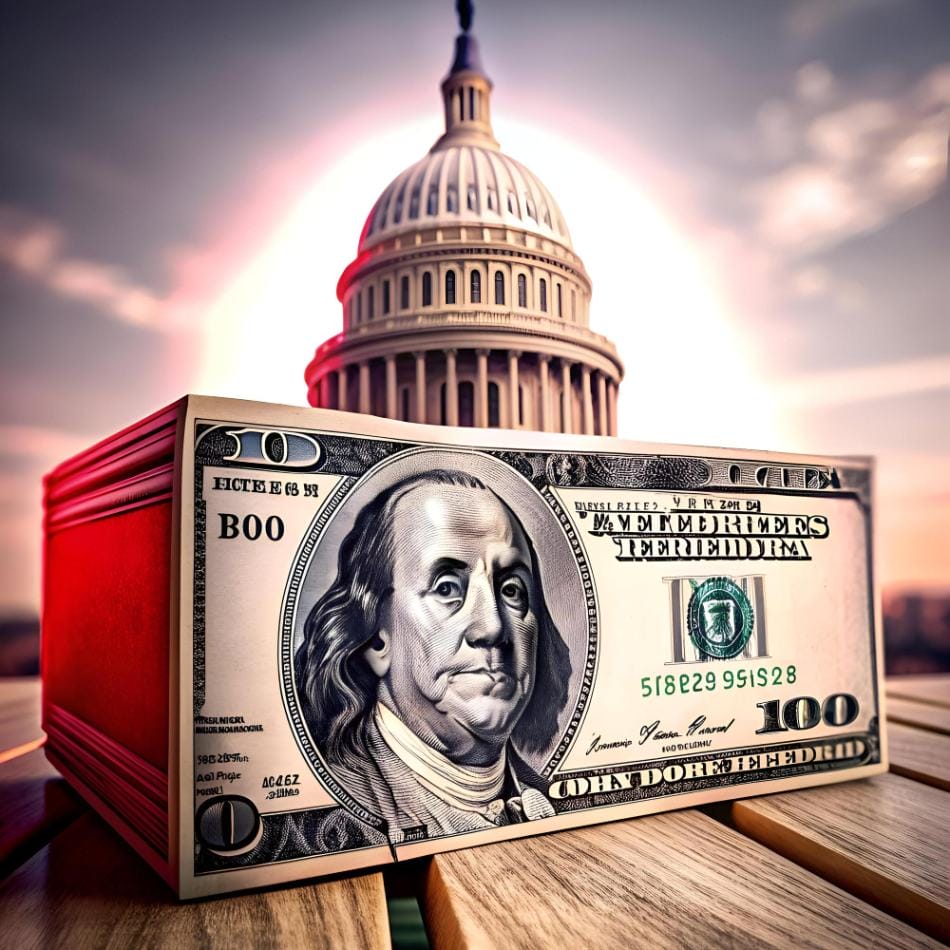
For example, in the UK, the recent Retail Sales boost could mean that consumers are feeling more confident in their finances, despite ongoing inflation concerns. More spending could be a sign that households are adjusting to higher prices, or that wages have caught up to some extent. Either way, it’s a positive indicator for both the economy and individuals.
Final Thoughts: The Road Ahead for the Pound and US Dollar
The recent recovery of the Pound Sterling against the US Dollar has been largely fueled by better-than-expected UK Retail Sales and a more optimistic outlook for the economy. While the BoE is likely to remain cautious in the short term, the resilience shown in consumer spending may reduce the need for immediate interest rate cuts. On the other side of the Atlantic, the US Dollar remains strong, bolstered by solid economic data and expectations of a gradual path for rate cuts by the Federal Reserve.
For traders, investors, and everyday people alike, the interaction between these two major currencies is something to watch closely in the coming months. Whether it’s the political landscape in the US or the evolving economic situation in the UK, the GBP/USD pair will likely continue to be influenced by a range of factors, including consumer behavior, inflation, and central bank policies.
In the end, what we see in the currency markets is often a reflection of the broader economic landscape, making it all the more important to keep an eye on key data releases like Retail Sales, inflation figures, and interest rate decisions.
USDCHF – USD/CHF Maintains Strength Over 0.8650 Amid Gradual Fed Rate Cut Hints
USD/CHF: Resilience Amid Market Changes and Policy Shifts
The USD/CHF pair has been holding firm around its recent gains as traders adapt to changing expectations about the Federal Reserve’s approach to interest rate cuts. The broader economic and political landscape, both in the United States and Switzerland, is also playing a role in shaping the currency pair’s movement. As market participants evaluate new economic data, shifting political dynamics, and potential central bank policies, the USD/CHF continues to be a currency pair worth watching.
Why Traders Are Watching USD/CHF Closely
The USD/CHF currency pair has been experiencing notable movements lately, with traders focusing on several factors that influence both the US Dollar and the Swiss Franc. As a trader, if you’re keeping an eye on USD/CHF, you’re likely weighing the impact of interest rate expectations, political uncertainty, and economic resilience.
Interest Rate Expectations: A Shift in Market Sentiment
One of the main reasons behind the recent uptick in USD/CHF has been the recalibration of interest rate expectations in the United States. Initially, there was speculation that the Federal Reserve might take aggressive action and cut rates by as much as 50 basis points (bps) in their upcoming meetings. However, following a series of surprisingly positive economic reports, those expectations have started to shift.
For instance, US economic data, including Nonfarm Payrolls (NFP), the ISM Services PMI, and retail sales, have all indicated that the US economy is holding strong. When the data exceeds expectations, it gives the Fed less reason to pursue aggressive rate cuts. Traders, therefore, have begun pricing in a more moderate approach by the Fed. Rather than a large 50 bps cut, market consensus is now leaning towards smaller, more measured cuts—perhaps 25 bps each in the upcoming November and December meetings.
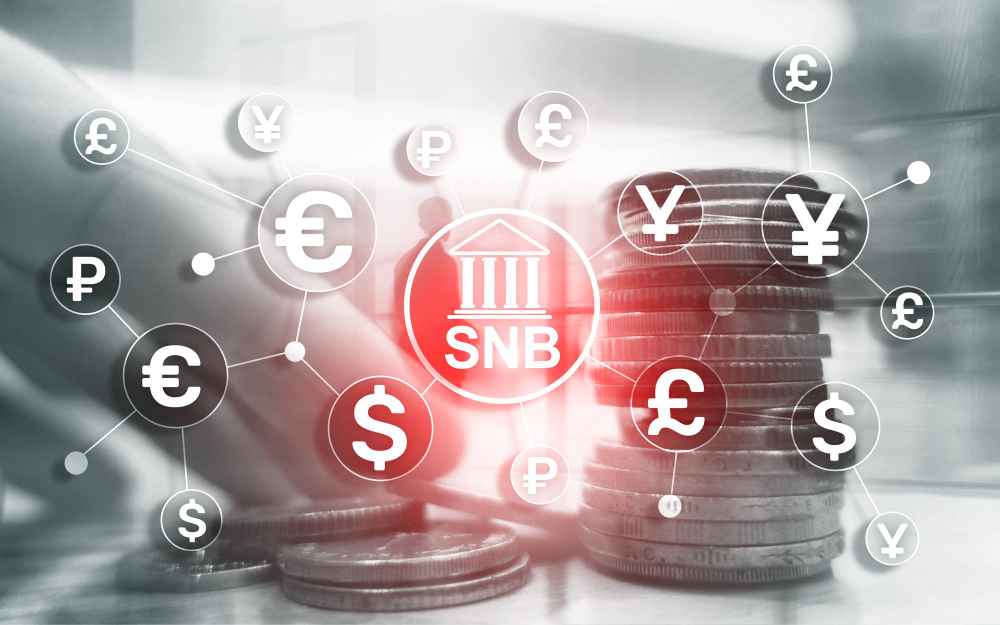
This shift in sentiment has bolstered the US Dollar, which in turn has impacted USD/CHF, allowing the pair to maintain its upward momentum.
US Economic Resilience: A Key Factor for USD Strength
The strength of the US economy has been a central theme lately, particularly as it relates to the Federal Reserve’s monetary policy decisions. Several key reports have shown that the US economy is more resilient than many had anticipated, which is causing traders to reconsider earlier expectations for steep interest rate cuts.
Nonfarm Payrolls and ISM Services PMI: Signs of Growth
Nonfarm Payrolls (NFP) data showed that the labor market continues to grow, with more jobs being added than previously expected. Similarly, the ISM Services PMI, which measures the health of the services sector, also posted stronger-than-anticipated results. When these indicators point to a healthy and growing economy, it reduces the urgency for the Federal Reserve to cut interest rates dramatically.
Retail Sales: Consumers Keep Spending
Another indicator of economic resilience has been the strength of US retail sales. When retail sales come in higher than expected, as they did in the most recent report with a 0.4% rise, it suggests that consumers are still willing to spend, even amid concerns about inflation and higher interest rates. This further reinforces the idea that the US economy is not in dire need of aggressive monetary policy easing.
Swiss National Bank: Easing Policy in Response to Lower Inflation
On the other side of the USD/CHF equation, the Swiss Franc has been impacted by the actions of the Swiss National Bank (SNB). The SNB has been taking a more dovish stance recently, in part due to falling inflation in Switzerland. When inflation is low, central banks are more likely to ease monetary policy by cutting interest rates, which can weaken a country’s currency.
Falling Inflation in Switzerland: A Boon for Rate Cuts
In September, Switzerland’s Consumer Price Index (CPI) fell to 0.8%, the lowest level in over three years. This drop in inflation has sparked expectations that the SNB will continue to cut interest rates in an effort to stimulate the economy and bring inflation closer to its target.
As the SNB pursues more interest rate cuts, it puts downward pressure on the Swiss Franc, making the currency less attractive to traders. When paired with a stronger US Dollar, this can lead to upward momentum in USD/CHF, as we’ve seen in recent weeks.
Political Factors: The Upcoming US Presidential Election
Beyond interest rates and economic data, political factors are also influencing the USD/CHF pair. With the US presidential election on the horizon, traders are paying close attention to the political landscape. Markets tend to react to election outcomes, especially if there’s uncertainty about who will win or how policies might change under different leadership.

USDCHF has broken a minor resistance area, which has now turned into a new support level
Election Polls: The Impact on the US Dollar
In the lead-up to the election, polling data can influence market sentiment. As of now, Democratic candidate Kamala Harris is leading former President Donald Trump in some polls. If Harris maintains her lead, markets might start to price in expectations for how her administration’s policies could affect the economy and the US Dollar. Political uncertainty can often lead to volatility in currency markets, and the closer we get to the election, the more this factor may play a role in USD/CHF movements.
Looking Ahead: What’s Next for USD/CHF?
As we move forward, traders will continue to monitor several key factors that could impact the USD/CHF pair. With upcoming Federal Reserve meetings, additional economic reports, and political developments, there’s no shortage of events that could cause further fluctuations in the currency pair.
If the US economy continues to show resilience, it’s likely that the Federal Reserve will maintain a more cautious approach to interest rate cuts, which could support the US Dollar. At the same time, if the Swiss National Bank continues to ease policy, the Swiss Franc could remain under pressure, providing further support for USD/CHF.

What Should Traders Watch For?
- Federal Reserve Announcements: Keep an eye on statements from the Fed regarding interest rates. Any hints about future rate cuts could have a significant impact on USD/CHF.
- US Economic Data: Reports on employment, retail sales, and inflation will give insight into the strength of the US economy, which in turn will influence expectations for the Fed’s next moves.
- Swiss National Bank Policies: Watch for any signals from the SNB regarding interest rates or other monetary policy actions. A more dovish stance could weaken the Swiss Franc further.
- Political Developments: As the US presidential election approaches, expect increased volatility in the markets. Any significant changes in polling data or election outcomes could affect the US Dollar.
Summary: USD/CHF’s Path Forward Amid Economic Shifts
The USD/CHF pair has been moving higher recently, driven by a combination of economic resilience in the US, shifting expectations for Federal Reserve interest rate cuts, and the Swiss National Bank’s easing policies. With both economies taking different approaches to monetary policy, traders will need to stay informed and adapt to new developments as they unfold.
While the road ahead remains uncertain, there are plenty of opportunities for traders to capitalize on USD/CHF’s movements. By staying informed about key economic indicators, interest rate announcements, and political developments, traders can make more informed decisions and potentially benefit from the pair’s ongoing fluctuations.
USDCAD – USD/CAD Holds Steady Around 1.3800 as Traders Await Fed Insights
USD/CAD Trading: What Investors Need to Know About the Current Market
The world of currency trading can be fast-paced, and keeping up with the latest updates on pairs like USD/CAD is vital for traders. This article will dive into the factors influencing the USD/CAD pair and explore what’s currently happening in the market, giving you an edge as an investor or curious trader.
The Sideways Movement of USD/CAD Near 1.3800
Currently, the USD/CAD currency pair is trading within a narrow range near 1.3800, showing signs of hesitation in the market. Investors seem to be in a holding pattern, awaiting signals and guidance from key players in the financial world, specifically from officials of the United States Federal Reserve (Fed). The sideways movement of the USD/CAD can be attributed to the uncertainty that comes with anticipating changes in monetary policies.
Why Are Investors Holding Their Breath?
There’s a lot of focus on speeches from several high-ranking members of the Federal Reserve. These speeches are critical because they offer clues about what the Fed plans to do with interest rates in the near future. Investors want to know whether the Fed will continue with its current stance or if changes are on the horizon that could shake up the markets. Traders are carefully analyzing the words of influential figures like Raphael Bostic, Neel Kashkari, and Christopher Waller to get a better understanding of future policy actions.

Federal Reserve Interest Rate Outlook
The Federal Reserve’s decisions on interest rates play a huge role in influencing the value of the USD. Right now, the Fed is expected to follow a moderate path in cutting interest rates over the coming months. But how do we know this? It comes down to data like the CME FedWatch Tool, which tracks the probability of interest rate changes. According to this tool, there’s a strong possibility that the Fed will reduce rates by a total of 50 basis points (bps) before the year ends. This would mean two more cuts of 25 bps in November and December.
Why Does This Matter?
Interest rate cuts generally make borrowing cheaper, encouraging spending and investment. However, they can also reduce the yield on investments that are interest-rate sensitive, such as bonds. This influences the value of the USD as lower interest rates can make the currency less attractive to investors. In simple terms, when interest rates go down, the USD can weaken, making it less appealing for foreign investors.
Economic Data Suggests a Moderate Approach
Recent data from the United States has given the Fed some breathing room when it comes to aggressive rate cuts. The economy seems to be stabilizing, reducing fears of a significant economic slowdown. This allows the Fed to take a more cautious, moderate approach rather than slashing rates rapidly to stave off a potential downturn. As long as the economy holds steady, we’re likely to see slow and measured interest rate cuts.
The Canadian Dollar (CAD) and Its Struggles
On the flip side, we have the Canadian Dollar (CAD), which has been under pressure recently. The Bank of Canada (BoC) is facing its own challenges and is expected to cut interest rates again in an attempt to stimulate job growth and revitalize the economy. So far, the BoC has already lowered its borrowing rate by 75 bps this year, bringing it to 4.25%. However, more cuts seem to be on the horizon as the central bank aims to control inflation while addressing concerns about the labor market.
Canada’s Economic Struggles: Employment and Inflation
One of the primary reasons for the BoC’s rate-cutting strategy is the rising unemployment rate in Canada. Despite efforts to stabilize the economy, the unemployment rate climbed to 6.6% in September, which is significantly higher than the BoC’s target of 5%. A high unemployment rate indicates that the economy isn’t operating at its full potential. It also suggests that more Canadians are out of work or struggling to find jobs, which can lead to decreased consumer spending and slower economic growth overall.

USDCAD is moving in a box pattern
With inflationary pressures appearing to be under control for now, the BoC has more room to focus on reducing interest rates to help stimulate the job market and encourage businesses to invest and hire more workers. The hope is that by lowering interest rates, businesses will have better access to cheap capital, making it easier to grow and hire more employees.
What’s Next for USD/CAD?
As both the US Federal Reserve and the Bank of Canada face their respective economic challenges, the USD/CAD pair could continue to see sideways movement in the short term. However, as interest rates shift and economic data is released, we could see significant changes in this currency pair’s value.
In the United States, traders will keep a close eye on further speeches from Fed officials and any updates on the economy’s performance. Positive economic data could lessen the need for aggressive rate cuts, which would support the USD. Conversely, signs of economic trouble could lead to further rate cuts, putting downward pressure on the USD.

In Canada, all eyes are on the BoC and its next moves to address the employment situation. If the BoC follows through with more rate cuts, the CAD could weaken further, making the USD/CAD pair more volatile.
Key Takeaways for Investors
At the end of the day, currency pairs like USD/CAD are influenced by a wide range of factors, but interest rates and economic data tend to play some of the most significant roles. Here are a few key takeaways for investors keeping an eye on the USD/CAD:
- Fed’s Policy Moves: The Federal Reserve’s upcoming interest rate decisions will likely be the primary driver of USD movement in the near term. Keep an eye on any news or speeches from Fed officials for hints about future policy changes.
- BoC’s Rate Cuts: The Bank of Canada’s response to the rising unemployment rate could lead to more rate cuts, which would impact the value of the CAD. More rate cuts will likely weaken the CAD further.
- Economic Data: Both US and Canadian economic data are crucial to predicting future moves in the currency markets. Stay informed on employment figures, inflation, and overall economic growth for both countries.
Final Summary
The USD/CAD pair is currently trading in a tight range, as investors wait for clarity on future interest rate moves from both the Federal Reserve and the Bank of Canada. While the Fed is expected to follow a moderate path in cutting rates, the BoC is likely to cut rates further to address rising unemployment. As these interest rate decisions unfold, they will shape the future of the USD/CAD pair, making it important for investors to stay informed about economic data and policy changes. Whether you’re new to trading or a seasoned pro, keeping an eye on these factors will help you navigate the market with greater confidence.
USD Index – US Dollar Eases as Federal Reserve Insights Shape Market Sentiment
US Dollar Weakens After A Week of Strong Gains Amid Chinese Stimulus Measures
The US dollar (USD) took a breather on Friday after a robust performance throughout the week, driven by economic factors from both the United States and global markets. Friday’s retracement came after China introduced additional economic stimulus measures to support its slowing economy, sparking some profit-taking among traders who had ridden the dollar’s earlier surge. With China stepping up efforts to bolster its economy through rate cuts and stimulus programs, it appears the rally in the US dollar may be slowing down, at least temporarily.
In this article, we’ll break down what’s been happening with the US dollar, why it’s seeing some weakness, and what to expect in the coming days. Let’s dive into the details of how the global markets are reacting and what might be ahead for the greenback.
The US Dollar’s Rally: What’s Happening?
The US dollar has been on a steep upward trajectory this past week, gaining strength against several major currencies. Investors flocked to the dollar amid concerns about global economic uncertainty, particularly with China’s slowing growth. The demand for a safe-haven currency like the USD pushed its value higher.
However, as we headed into Friday, the tide started to turn. Traders began taking profits after the dollar’s strong rally, leading to a slight decline in its value. What caused this shift? Let’s take a closer look.
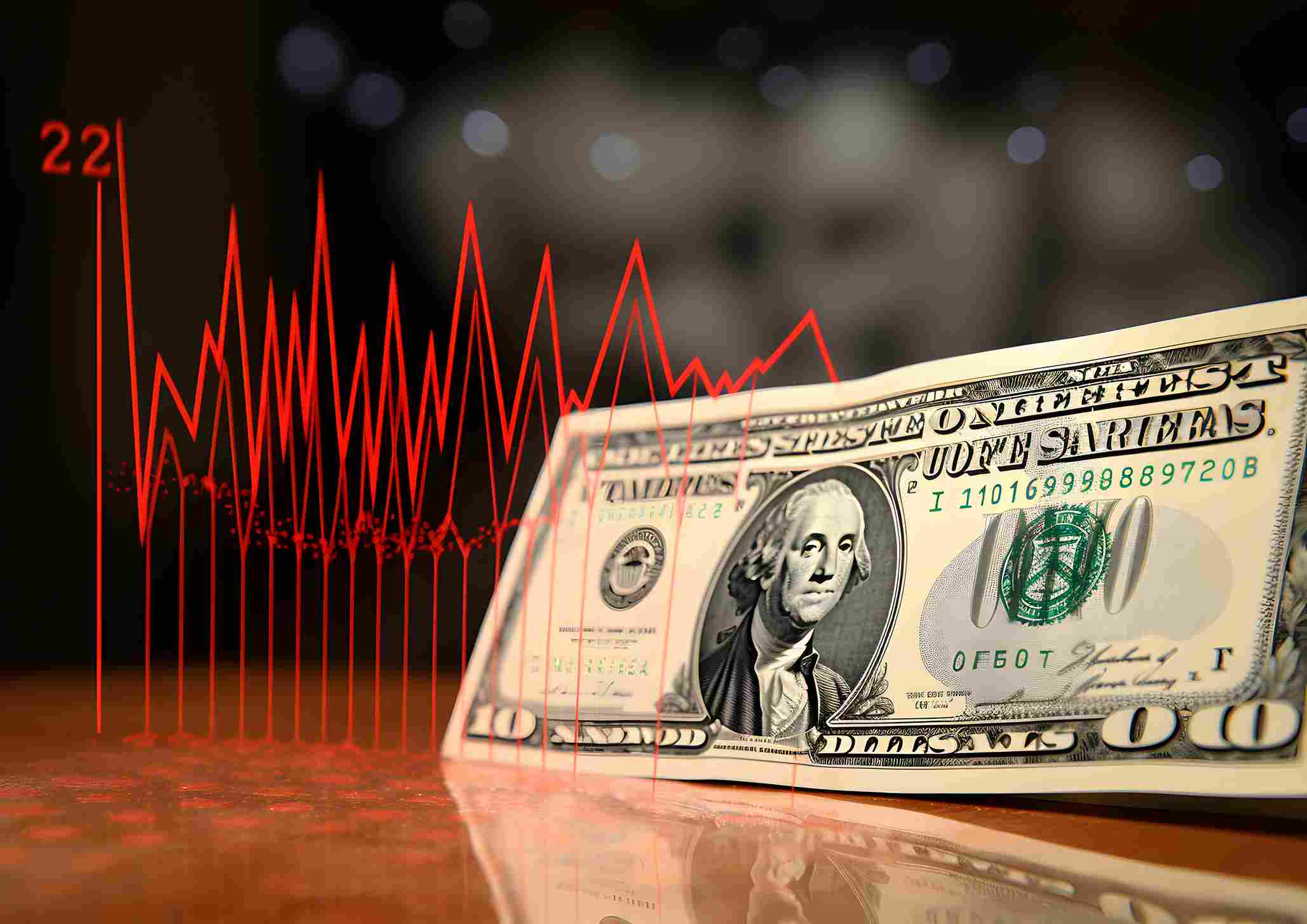
China Steps In With Stimulus Measures
China has been grappling with economic slowdowns in recent months, prompting its government to step up efforts to stimulate growth. On Friday, China announced further cuts to deposit rates, alongside additional details of a broader stimulus package designed to give the economy a much-needed boost.
This move had a significant impact on global markets, including the US dollar. When a major economy like China signals that it’s taking steps to support growth, it can lead to changes in currency values, as we’re seeing now. By lowering deposit rates and rolling out more stimulus, China is aiming to encourage borrowing and investment, which could potentially stabilize its economy.
For traders, this means a shift in focus from the US dollar to other currencies that may benefit from China’s actions. The result? Some traders are taking their profits from the dollar’s earlier rally, leading to a slight easing in its value.
A Quiet Day on the US Economic Calendar
Friday’s economic calendar in the US was relatively light, with few major data points expected to influence the market. Typically, significant economic reports can drive the value of the US dollar, but with no major announcements, the market remained focused on external factors, such as China’s stimulus measures.
The only notable data release came from the housing sector, with building permits and housing starts for September showing slight declines compared to previous months. However, these figures didn’t carry enough weight to cause a major shift in the dollar’s value, leaving the currency more susceptible to global influences.
Fed Speakers Step Into the Spotlight
While the economic calendar was light, the day wasn’t entirely without action. Several Federal Reserve officials were scheduled to speak throughout the day, providing insight into the Fed’s current thinking on monetary policy and the economy.
These speeches can sometimes move markets, depending on what’s said, particularly if any of the officials hint at future interest rate moves. However, there were no groundbreaking comments made, leaving the dollar largely unaffected by the day’s events.

USD Index Market price is moving in a box pattern, and the market has rebounded from the support area of the pattern
Fed officials have been closely watched in recent months as markets try to gauge the central bank’s next moves. With inflation still a concern, there’s been plenty of speculation about whether the Fed will continue raising interest rates or hold steady in the coming months. For now, the market seems to be leaning toward the latter, which could explain some of the cooling off in the dollar’s rally.
Looking Ahead: What’s Next for the US Dollar?
So, what can we expect for the US dollar in the coming days and weeks? While the dollar’s rally appears to have hit a temporary roadblock, it’s far from over. The global economic landscape is still filled with uncertainties, and the dollar remains a popular safe-haven currency for investors.
However, China’s stimulus measures could continue to impact the dollar, especially if they start to show signs of successfully boosting the Chinese economy. If global growth improves, we might see the dollar lose some of its appeal as traders shift their focus to riskier assets.
Additionally, attention will remain on the Federal Reserve and its future monetary policy decisions. Any hints of rate cuts or pauses in rate hikes could influence the dollar’s trajectory in the weeks ahead. Market participants will be closely watching upcoming data releases and Fed speeches for clues about what’s next for US monetary policy.
The Role of Global Markets
It’s also important to keep an eye on what’s happening in other global markets. European equities, for example, have been reacting to comments from European Central Bank (ECB) President Christine Lagarde, who has highlighted challenges facing the European economy. Similarly, Asian equities, particularly in China, have been buoyed by the latest wave of stimulus measures.

These global developments can have a ripple effect on the US dollar, especially if they lead to increased investor confidence in other currencies. For now, though, the dollar remains a key player in the global market, and its value will continue to be influenced by both domestic and international factors.
Summary
The US dollar has experienced a strong rally throughout the week, driven by global economic uncertainty and a flight to safety by investors. However, as we reached Friday, the dollar saw some weakness as traders took profits following the introduction of fresh stimulus measures by China. By cutting deposit rates and rolling out additional economic support, China is taking steps to prop up its slowing economy, which has had a ripple effect on global markets, including the value of the US dollar.
With a relatively quiet day on the US economic calendar and several Federal Reserve officials scheduled to speak, the focus for traders remains on external factors, such as China’s actions and future Fed policy decisions. Looking ahead, the dollar’s rally may pause, but it’s still likely to remain a key player in the global market, with plenty of attention on upcoming economic data and central bank moves.
As we navigate the next few weeks, the US dollar will continue to react to both domestic and international developments, and traders will need to stay alert to any shifts in the economic landscape. Whether the dollar regains its momentum or continues to ease will depend on a variety of factors, including the success of China’s stimulus efforts and the Fed’s approach to monetary policy.
EURGBP – Pound Strengthens Against Euro: EUR/GBP Slumps After UK Retail Surge and ECB Policy Shift
EUR/GBP Hits a New Low in 2024: What’s Behind the Decline?
The EUR/GBP pair reached its lowest point in 2024, leaving many traders and investors curious about the forces driving this decline. If you’ve been keeping an eye on this currency pair, you might have noticed how the British Pound (GBP) is gaining strength, while the Euro (EUR) is losing momentum. Let’s break down why this is happening, what’s influencing these two currencies, and what it could mean for the future of the EUR/GBP pair.
Why Is the Pound Sterling Strengthening?
One of the key reasons behind the recent strength of the British Pound is the surprising UK Retail Sales report. In September, data showed that British shoppers were spending more than anticipated. This positive retail sales figure gave the GBP a significant boost. But what does retail spending have to do with currency value? Let me explain.
The Connection Between Retail Sales and Currency Value
Retail sales are a strong indicator of the health of a country’s economy. When people spend more, it suggests that they are confident in the economy, and this tends to have a positive impact on the currency. In the case of the UK, September’s data showed a 0.3% rise in retail sales, defying expectations of a 0.3% decline.
This unexpected increase suggests that the UK’s economy is stronger than previously thought, which influences how the Bank of England (BoE) approaches its monetary policies, particularly interest rates.

What Does the Bank of England’s Interest Rate Mean for GBP?
Currently, the Bank of England’s interest rate is at 5.00%, one of the highest among Western central banks. High interest rates typically attract foreign investment, as investors seek higher returns on their investments. This influx of foreign capital increases demand for the British Pound, which in turn strengthens its value.
As long as the BoE maintains these elevated rates, the Pound is likely to stay strong. This strength makes the GBP more attractive than other currencies, like the Euro, and is a key reason behind the current EUR/GBP exchange rate movements.
Why Is the Euro Weakening?
While the Pound is gaining strength, the Euro is facing challenges. One of the major factors causing the Euro to weaken is the recent decision by the European Central Bank (ECB) to cut interest rates. In fact, the ECB has now cut rates at two consecutive meetings, signaling a quicker pace of monetary easing.
Understanding the ECB’s Easing Cycle
When a central bank like the ECB cuts interest rates, it essentially makes borrowing cheaper, which can help stimulate economic activity. However, it also makes the currency less attractive to foreign investors, leading to a drop in demand. This is what’s happening to the Euro right now. With the ECB cutting rates by 0.25%, bringing the key deposit facility rate down to 3.25%, the Euro has become less appealing to investors, especially when compared to the Pound.
Additionally, ECB President Christine Lagarde’s comments further emphasized the likelihood of more rate cuts ahead. The ECB’s cautious tone, paired with its focus on supporting economic growth, suggests that the Euro may continue to face downward pressure in the coming months.
Diverging Monetary Policies: What It Means for EUR/GBP
The most important takeaway from this situation is the divergence in monetary policies between the Bank of England and the European Central Bank. While the BoE is maintaining high interest rates, the ECB is cutting them. This difference in policy directions is one of the primary reasons why the EUR/GBP pair has reached new lows.
When two currencies have vastly different monetary policies, it often leads to sharp movements in their exchange rate. In this case, the GBP is benefiting from higher rates, while the EUR is being pushed down by lower rates. This divergence could continue to drive the EUR/GBP pair lower in the short term.
Analysts’ Views on the Future of EUR/GBP
Analysts are paying close attention to these monetary policy differences, and many believe that EUR/GBP could continue to fall. For example, experts from financial institutions such as Brown Brothers Harriman (BBH) have pointed out that the policy trends favor a stronger Pound and a weaker Euro in the near future. They note that the recent UK Retail Sales data reinforced this outlook, making it likely that the Pound will remain dominant over the Euro for the time being.

EURGBP is moving in a box pattern, and the market has reached the support area of the pattern
Could UK Interest Rates Fall in the Long Run?
While many analysts agree that the Pound will stay strong in the short term, some experts believe that UK interest rates could eventually come down. Alex Kerr, an economist at Capital Economics, suggests that while rates are high now, the BoE might reduce them gradually over the next few years. He predicts that rates could fall from the current 5.00% to 3.00% by early 2026.
However, this forecast comes with a caveat. If the UK government increases investment, rates might not drop as quickly as anticipated. The future of the GBP will largely depend on how the economy performs in the long run, but for now, the Pound remains in a strong position.
Will the Euro Continue to Struggle?
On the other hand, the Euro may continue to face challenges, especially if the ECB keeps cutting rates. Analysts are predicting more rate cuts from the ECB, which could keep the Euro under pressure. The central bank’s focus on easing policies to support the economy may lead to further declines in the EUR/GBP pair.

Final Thoughts: What’s Next for EUR/GBP?
The recent fall in EUR/GBP to its lowest point of 2024 is largely driven by the diverging paths of the Bank of England and the European Central Bank. With the BoE maintaining high interest rates and the ECB cutting theirs, it’s no surprise that the Pound is gaining ground against the Euro.
For traders and investors, the key takeaway is to keep an eye on these central bank policies. As long as the BoE remains committed to higher rates, the GBP is likely to stay strong. Meanwhile, the ECB’s easing cycle could keep the Euro under pressure, making it a less attractive currency in the near future.
If you’re involved in trading or investing in the EUR/GBP pair, staying informed about central bank decisions and economic data will be crucial in navigating these currency movements. With the current trends, we could see EUR/GBP decline even further in the coming months, but as always in the financial world, it’s important to stay cautious and informed.
AUDUSD – Weaker US Dollar Sparks Australian Dollar Comeback
The Aussie Dollar Gains Momentum: Strong Employment Data and Weaker US Dollar Drive Growth
The Australian Dollar (AUD) has been showing some positive movements lately, driven by a combination of domestic strength and external factors. The recent weakening of the US Dollar and strong employment figures from Australia have played significant roles in pushing the AUD higher. In this article, we’ll break down what’s behind the recent boost for the Aussie Dollar, the factors influencing its rise, and what could be next on the horizon.
What’s Driving the Aussie Dollar’s Rise?
Stronger Employment Data Boosts Confidence
One of the key drivers of the recent strength in the Australian Dollar is the strong employment data that was released this week. Employment in Australia increased by an impressive 64.1K, a number slightly above what was already strong data in August. The majority of these gains came from full-time positions, showing that the labor market is not just recovering but thriving. This strong growth in jobs has kept the unemployment rate low, adjusted down to 4.1%, which is close to historical lows.
This data paints a picture of a resilient Australian economy, one that might give the Reserve Bank of Australia (RBA) reasons to rethink its monetary policy. While there was previously an expectation of a 25 basis point rate cut in 2024, the strength of the recent data could make it harder for the RBA to justify such a move. If the economic data continues to be strong, the possibility of rate cuts might be taken off the table, which would likely support the Aussie Dollar even further.

Weaker US Dollar Lifts AUD
Another factor that has contributed to the AUD’s rise is the recent weakness of the US Dollar. The US Dollar is often viewed as a safe-haven currency, meaning it tends to strengthen when investors are feeling risk-averse. However, with global risk sentiment improving and a shift toward more risk-on behavior in equity markets, the demand for the US Dollar has softened. This has allowed other currencies, like the Australian Dollar, to gain some ground.
When the US Dollar weakens, it makes other currencies relatively more attractive, particularly those from economies showing positive economic data, like Australia. The combination of a softer US Dollar and strong domestic employment figures has given the Aussie Dollar the perfect environment to thrive.
Factors Limiting the Aussie Dollar’s Gains
While the Australian Dollar has had a good run recently, not everything is smooth sailing. A couple of factors have limited the potential for even greater gains.
China’s Economic Slowdown Affects Risk Sentiment
Australia’s economy is closely tied to China due to the strong trade relationship between the two nations. As China is a major importer of Australian commodities, any economic slowdown in China can have a significant impact on Australia. Unfortunately, China has been facing some economic challenges recently, with slower-than-expected growth. This has weighed on global risk sentiment and, by extension, limited the AUD’s potential for bigger gains.
Even though Australia’s domestic economy is doing well, the concerns about China’s economic future act as a ceiling for the Aussie Dollar’s rise. The uncertainty around China’s economy means that, while the AUD is benefiting from positive domestic factors, there’s still some hesitation among investors about how much higher it can go in the near term.
Weak Housing Data Weighs on USD
On the flip side, another factor helping to weaken the US Dollar is the soft housing data coming out of the United States. Housing is a significant part of the US economy, and recent data has shown that the sector isn’t performing as well as expected. This has put some downward pressure on the USD, contributing to the relative strength of other currencies, including the AUD.
RBA’s Hawkish Outlook and What It Means for the AUD
With the release of strong employment data, expectations around the Reserve Bank of Australia’s (RBA) policy decisions have started to shift. For some time, market consensus had been that the RBA would cut interest rates by 25 basis points at some point in 2024. However, as the Australian economy continues to outperform, these expectations are beginning to change.
Could the RBA Hold Off on Rate Cuts?
If the employment and economic growth figures continue to be this strong, the RBA might feel less pressure to implement a rate cut. In fact, there could even be a scenario where the RBA maintains its current rates or moves towards a more hawkish stance (favoring rate hikes) in response to continued economic strength. This would likely provide additional support to the Aussie Dollar, as higher interest rates typically attract foreign investors looking for better returns.

That said, it’s still too early to tell what the RBA’s final decision will be. They will likely continue to monitor economic data closely before making any major moves. However, if things continue on their current trajectory, we may see the odds of a rate cut continue to diminish.
Final Thoughts: What to Expect Next for the Aussie Dollar
The Australian Dollar has been on a steady rise recently, thanks to strong employment data and a weaker US Dollar. However, it’s important to keep in mind that external factors, such as China’s economic situation, still play a significant role in limiting the AUD’s gains. For now, the combination of a resilient Australian economy and favorable global risk sentiment is helping the AUD maintain its upward momentum.
Looking ahead, much will depend on how the Reserve Bank of Australia responds to the strong economic data. If they hold off on rate cuts or take a more hawkish stance, we could see further strength in the Australian Dollar. On the other hand, any signs of weakness in China or a stronger recovery in the US could limit the AUD’s potential gains.
In the short term, the Aussie Dollar seems well-positioned for more growth, but investors should keep an eye on external factors that could influence its future performance. For now, it’s all about watching how the domestic and global economies develop and adjusting expectations accordingly.
NZDUSD – Kiwi Dollar Edges Higher Near 0.6070 as USD Eases, Bearish Sentiment Still Strong
NZD/USD Holds Steady Amid USD Weakness and Mixed Chinese Data
The NZD/USD currency pair has caught the attention of traders once again, as it experiences some modest buying interest. This article will break down the factors influencing the pair’s movement, examine key drivers behind the recent market activity, and look into why there seems to be a cautious optimism surrounding the NZD/USD pairing, despite underlying uncertainties.
The market is a complex, ever-changing entity, and in this article, we’ll explore how the New Zealand dollar (NZD) is performing against the US dollar (USD) and how various factors—such as the US Federal Reserve’s (Fed) policies, China’s economic performance, and the Reserve Bank of New Zealand’s (RBNZ) outlook—play pivotal roles in shaping the market sentiment around this currency pair.
USD Weakness Sparks Renewed Interest in NZD/USD
One of the primary factors helping the NZD/USD pair gain some traction recently has been a softening of the US dollar. The USD has been on an upward trend for much of the past month, driven by various factors, but traders seem to be taking profits off the table, which is a normal occurrence after a strong rally.
The USD Index (DXY), which measures the strength of the dollar against a basket of other major currencies, has retreated from its recent highs. This easing in USD strength provides a much-needed boost for the Kiwi (NZD), a currency that is often sensitive to broader market movements and global economic sentiment.

For traders and investors, it’s important to remember that when the USD weakens, other currencies often benefit—particularly those like the NZD, which is seen as a risk-sensitive asset. The market’s willingness to step back from the USD is giving the NZD/USD pairing some breathing room, but there are still some challenges on the horizon.
The Influence of Chinese Economic Data
While the softer USD gives the NZD some support, not all is smooth sailing. China’s economic performance is another significant factor influencing the NZD, given the strong trade links between New Zealand and China.
Earlier this week, China released a set of economic data that presented a mixed picture. The country’s GDP growth for the third quarter slowed to 4.6% year-on-year, marking the lowest reading in 18 months. This is slightly below expectations and has raised concerns about a broader slowdown in the Chinese economy. Since China is a key trading partner for New Zealand, any signs of weakness in China’s economy can often weigh on the NZD.
On the flip side, some of China’s other economic indicators showed a bit more promise. Retail sales and industrial production data came in stronger than expected, offering a glimmer of hope that the Chinese economy isn’t headed for a complete downturn. However, the overall slowdown in GDP growth could continue to cast a shadow on the NZD, limiting its upside potential.
The Role of Central Banks: Fed vs. RBNZ
Central banks play a pivotal role in shaping currency movements, and in the case of NZD/USD, both the US Federal Reserve and the Reserve Bank of New Zealand have key roles to play.
The Fed’s Rate Cut Outlook
Market participants are now growing increasingly confident that the Fed will adopt a more cautious approach to rate cuts in the near future. The US economy remains resilient, and with inflation appearing to cool, there’s little incentive for the Fed to rush into aggressive rate cuts. However, the expectation that the Fed might opt for smaller cuts is helping to cap USD gains, providing an additional lift for the NZD.

NZDUSD is moving in a box pattern, and the market has fallen from the resistance area of the pattern
For the NZD/USD pair, this means that as long as the Fed remains cautious in its rate cuts, the pressure on the Kiwi is lessened. A stronger US dollar driven by aggressive Fed rate hikes would typically weigh down the NZD/USD pairing, but the current scenario provides some breathing space for the NZD to hold steady or even strengthen slightly.
Dovish Expectations from the RBNZ
On the flip side, the outlook for New Zealand’s own central bank, the RBNZ, is decidedly more dovish. With inflation now falling within the central bank’s target range, there is a growing belief that the RBNZ will likely proceed with rate cuts in the near term. In fact, the market is beginning to anticipate that the RBNZ could pursue more aggressive cuts to further support economic growth.
While these dovish expectations might seem like they would weaken the NZD, the currency hasn’t been overly weighed down just yet. This could be due to the fact that much of this dovish sentiment has already been priced into the market. However, should the RBNZ take more drastic action, it could introduce downward pressure on the NZD/USD pair.
What’s Next for the NZD/USD Pair?
With all of these factors in play, it’s easy to see why the NZD/USD pairing is attracting attention. A softer USD and a mixed economic outlook in China have provided some support to the pair, but there are still headwinds that could limit its upside potential.
Traders will be keeping a close eye on upcoming economic data, including US housing market reports and speeches from key Fed officials, to gauge where the market is headed next. Any surprises in this data could spark more volatility in the currency markets, leading to potential opportunities—or risks—for those trading the NZD/USD pair.

Navigating the Uncertainty
In the world of currency trading, uncertainty is often the only certainty. The NZD/USD pair is facing a range of influences, from the Fed’s cautious rate outlook to concerns about China’s slowing economy. Add in the RBNZ’s dovish stance, and it becomes clear that this pair is walking a tightrope between opportunity and risk.
For traders, this means it’s essential to stay informed about the latest developments in both the US and New Zealand economies, as well as broader global market trends. While the NZD/USD pair has attracted some buying interest, there’s still a sense of caution in the air, as many of the underlying issues affecting the pair remain unresolved.
Final Thoughts: A Wait-and-See Approach
In conclusion, while the NZD/USD pair has attracted some buyers thanks to a softer USD, there are still plenty of reasons to approach this pairing with caution. China’s economic performance remains a concern, and the Fed’s approach to rate cuts will continue to play a significant role in shaping the USD’s strength.
Meanwhile, the RBNZ’s dovish outlook adds another layer of uncertainty to the mix, as traders wait to see just how aggressive the central bank will be in cutting rates. For now, the NZD/USD pair remains in a delicate balance, with both risks and opportunities on the horizon.
As always, it’s important to stay informed, remain flexible, and be prepared for whatever the market throws your way. Whether you’re a seasoned trader or just starting out, keeping an eye on these key factors will help you navigate the ever-changing world of currency trading with confidence.
BTCUSD – Analysts Expect Crypto ETF Popularity to Rise Despite Early Hurdles
Big Investors Hesitant to Embrace Bitcoin Spot ETFs: What’s Holding Them Back?
Cryptocurrencies like Bitcoin and Ethereum have become hot topics of discussion in the financial world. With the introduction of Bitcoin and Ethereum spot ETFs (Exchange-Traded Funds), there was a wave of excitement that these investment products would make it easier for traditional investors to access the crypto market. But months after their launch, institutional investors, the big players in the financial world, remain cautious. The big question is: Why are they holding back?
In this article, we’ll break down the factors contributing to the slow adoption of Bitcoin spot ETFs by large institutions, explore why Ethereum ETFs may be lagging even further behind, and provide some insight into what this could mean for the future of cryptocurrency.
Bitcoin Spot ETFs: What Happened to the Hype?
When the U.S. Securities and Exchange Commission (SEC) approved the first Bitcoin spot ETFs earlier this year, it was hailed as a major milestone for the crypto world. Finally, institutional investors would have an easier, regulated way to invest in Bitcoin without directly buying and holding the asset themselves. This approval was expected to open the floodgates to a massive influx of traditional investor funds.
Initially, everything seemed to be going according to plan. As soon as the ETFs were listed, demand surged. Bitcoin’s price skyrocketed, reaching a new all-time high of over $73,000 in mid-March. There was talk in the financial world of Bitcoin eventually hitting $100,000, riding on this new wave of demand from institutional investors who had previously stayed on the sidelines.
However, fast forward six months, and the reality seems quite different from those bullish predictions. The volume of assets under management (AUM) in these Bitcoin ETFs has leveled off at around $60 billion, and the enthusiasm seems to have cooled. This has left many in the crypto community wondering if the optimism surrounding ETFs was overhyped.

Why Are Institutional Investors Wary?
So why haven’t the big players fully jumped on the Bitcoin ETF bandwagon? There are a few reasons for their hesitation:
1. Regulatory Concerns Still Linger
Even though the SEC has approved Bitcoin ETFs, regulatory uncertainty around cryptocurrencies remains a major concern. Governments and regulators around the world are still figuring out how to properly regulate this new asset class, and the rules can change rapidly. For large institutions that need stability and predictability, this ongoing regulatory flux makes them cautious about pouring large sums into Bitcoin ETFs.
2. Market Volatility
Bitcoin is known for its wild price swings. While this volatility can be attractive to day traders and retail investors looking for quick gains, institutional investors—especially those managing large amounts of money—tend to prefer more stable, predictable investments. The sudden price movements of Bitcoin can create risks that many traditional investors are unwilling to take on.
3. Lack of Long-Term Performance Data
For many institutional investors, the Bitcoin ETF market is still relatively new, and they may be waiting to see how these funds perform over a longer period. After all, making large allocations to a new and unproven market can be risky. These investors want to see consistent returns and stability before they commit fully.
4. Crypto’s Reputation
Despite Bitcoin’s growth over the years, some institutional investors are still hesitant because of cryptocurrency’s association with speculative trading, fraud, and hacking. The perception of risk can make traditional investors nervous about allocating significant funds to this space, even with the added legitimacy of an ETF.
Ethereum ETFs: Falling Behind Bitcoin
While Bitcoin spot ETFs have attracted a reasonable amount of attention, Ethereum ETFs seem to be lagging even further behind. There are a few reasons for this:
1. Bitcoin’s Market Leadership
Bitcoin has long been the dominant player in the crypto market, and many traditional investors view it as the safer bet compared to other cryptocurrencies. Ethereum, while second in market capitalization, still doesn’t have the same level of recognition or trust among traditional investors as Bitcoin does. Many investors consider Bitcoin to be the “gold standard” of crypto, making them more comfortable with it than other assets like Ethereum.
2. Complexity of Ethereum
Ethereum’s blockchain is known for its versatility, supporting smart contracts and decentralized applications (dApps). However, this complexity can be off-putting for investors who are not deeply familiar with the technical aspects of crypto. Bitcoin’s relatively simpler use case—as digital gold or a store of value—makes it more accessible to traditional investors. Ethereum’s broader functionality might add an extra layer of uncertainty for those less familiar with the technology.
3. Institutional Preference for Simplicity
Large investors often prefer simplicity when it comes to new investment products. Bitcoin ETFs offer a straightforward way to gain exposure to Bitcoin’s price movements. On the other hand, Ethereum’s more complex use cases and evolving ecosystem might make traditional investors hesitant. They might view Ethereum as a riskier and less mature investment than Bitcoin.

BTCUSD is moving in a descending channel, and the market has reached the lower high area of the channel
What’s Next for Crypto ETFs?
Despite the slow uptake so far, there’s still a strong case to be made for Bitcoin and Ethereum ETFs as long-term drivers of cryptocurrency adoption. As the market matures and more institutional investors gain confidence in the regulatory environment, we may see a significant increase in demand for these products.
1. Mid-Term Expectations: Patience Required
For now, it seems that the key to greater institutional involvement in Bitcoin and Ethereum ETFs is patience. The initial hype may have died down, but that doesn’t mean that these ETFs won’t eventually become a staple in the portfolios of major investment firms. As the crypto market stabilizes, regulations become clearer, and performance data accumulates, institutional investors could become more comfortable with allocating funds to these assets.
2. Ethereum’s Future in ETFs
While Ethereum ETFs may be trailing Bitcoin ETFs in terms of demand, they still have the potential to grow. Ethereum’s expanding ecosystem, particularly with the rise of decentralized finance (DeFi) and non-fungible tokens (NFTs), could eventually make it an attractive option for institutions looking to diversify their crypto exposure. As these markets mature, Ethereum may gain more institutional interest, especially if it continues to demonstrate its value beyond being a cryptocurrency.

3. The Role of Education and Awareness
A key factor in driving future demand for Bitcoin and Ethereum ETFs will be education. As more traditional investors become familiar with cryptocurrencies and understand how these ETFs can fit into their portfolios, demand could increase. Investment firms and ETF providers will need to focus on educating their clients about the potential benefits and risks of these products, helping them feel more comfortable entering the market.
Final Thoughts: Will Institutional Investors Eventually Jump In?
The introduction of Bitcoin and Ethereum ETFs was a significant step forward for the crypto industry, but it hasn’t been the game-changer that many expected—at least not yet. Institutional investors are taking their time, carefully weighing the risks before fully committing to these new investment products.
However, the potential is still there. As the crypto market continues to evolve, and as regulatory clarity improves, the door remains open for institutional investors to allocate more funds to Bitcoin and Ethereum ETFs in the future. For now, patience is key, and those who are already involved in the crypto market should keep an eye on these developments, as they could play a crucial role in the broader adoption of cryptocurrencies in the years to come.
Don’t trade all the time, trade forex only at the confirmed trade setups
Get more confirmed trade signals at premium or supreme – Click here to get more signals , 2200%, 800% growth in Real Live USD trading account of our users – click here to see , or If you want to get FREE Trial signals, You can Join FREE Signals Now!


